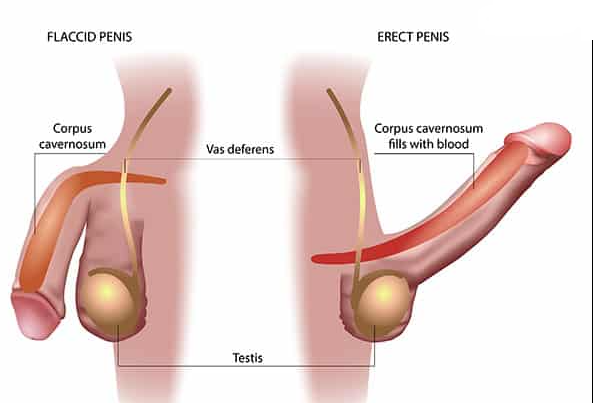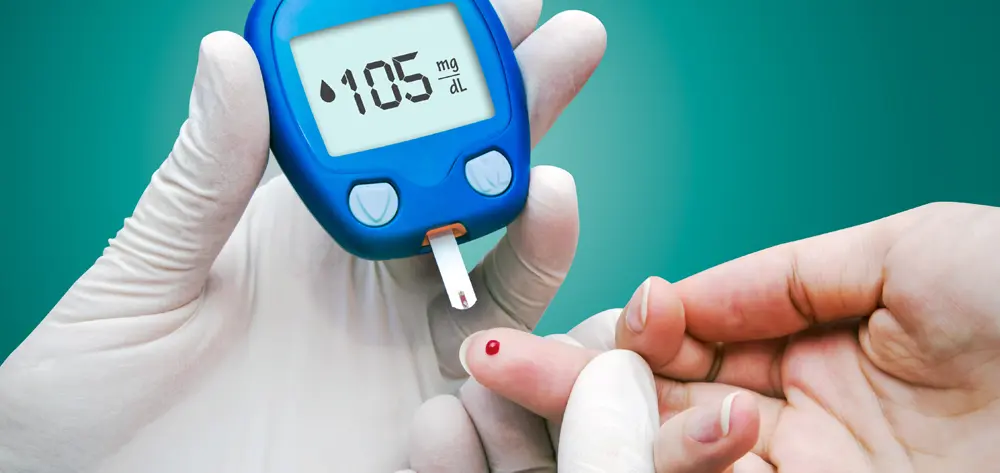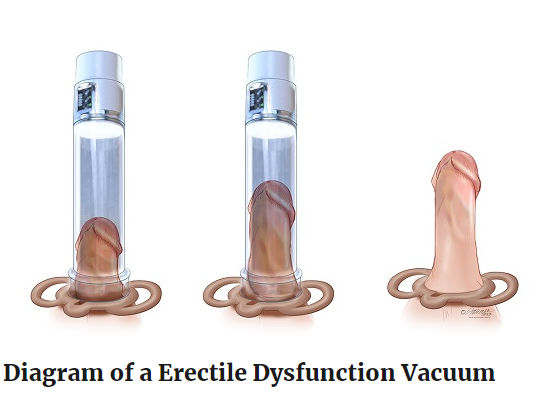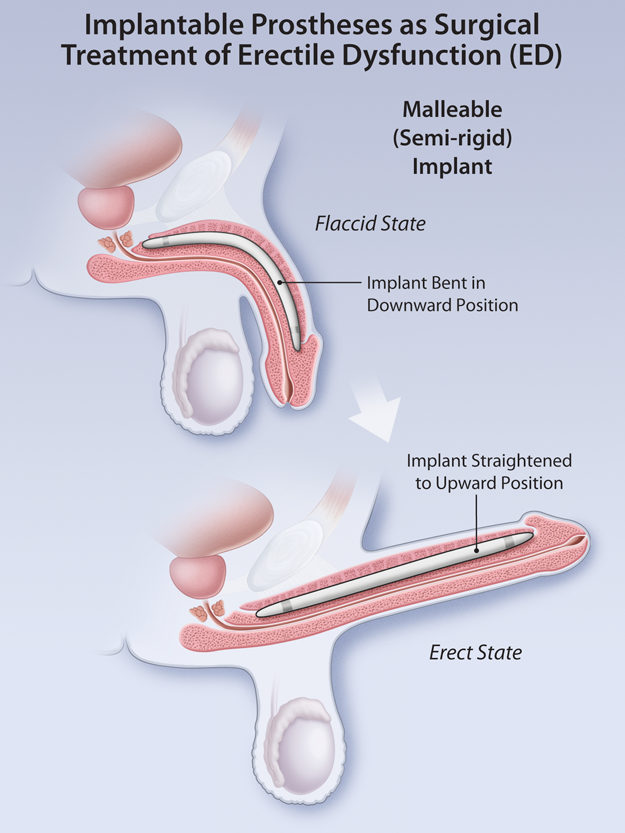Erectile dysfunction (ED) is the inability to get and keep an erection firm enough for sexual intercourse. Estimates suggest that one of every 10 men will suffer from ED at some point during his lifetime. It is important to understand that in most cases, ED is a symptom of another, underlying problem. ED is not considered normal at any age, and may be associated with other problems that interfere with sexual intercourse, such as lack of desire and problems with orgasm and ejaculation.

How common is erectile dysfunction?
Approximately one in 10 adult males will suffer from ED on a long-term basis.
Many men do experience occasional failure to achieve erection, which can occur for a variety of reasons, such as drinking too much alcohol, stress, relationship problems, or from being extremely tired.
The failure to get an erection less than 20% of the time is not unusual and typically does not require treatment. However, the failure to achieve an erection more than 50% of the time generally means that there is a problem and treatment is needed.
ED does not have to be a part of getting older. While it is true that some older men may need more stimulation, they should still be able to achieve an erection and enjoy intercourse.
What causes erectile dysfunction (ED)?
ED can be caused by a number of factors, including:
- Vascular disease: Blood supply to the penis can become blocked or narrowed as a result of vascular disease such as atherosclerosis (hardening of the arteries).
- Neurological disorders (such as multiple sclerosis): Nerves that send impulses to the penis can become damaged from stroke, diabetes, or other causes.
- Psychological states: These include stress, depression, lack of stimulus from the brain and performance anxiety.
- Trauma: An injury could contribute to symptoms of ED.
Chronic illness, certain medications, and a condition called Peyronie’s disease can also cause ED. Operations for the prostate, bladder, and colon cancer may also be contributing factors.
There are many potential causes for erectile dysfunction, such as these conditions/circumstances:
- Vascular conditions:
- High blood pressure
- Elevated cholesterol
- Cardiovascular disease
- Diabetes
- Trauma:
- Spinal cord injury
- Pelvis injury
- Neurologic disease:
- Stroke
- Parkinson’s disease
- Alzheimer’s disease
- Radiation to the pelvis for cancer
- Endocrine:
- Hypogonadism (low testosterone)
- Hyperprolactinemia (high prolactin levels)
- Pelvis surgery:
- Radical prostatectomy (a surgical procedure for the partial or complete removal of the prostate)
- Surgeries for rectal cancer or bladder cancer
- Medication side effects:
- Antidepressants
- Antihypertensives (high blood pressure medicine)
- Antiandrogens (testosterone blockers)
- Antiarrhythmics (heart rhythm medicine)
- Alcohol
- Cigarette smoking
- Cocaine and marijuana
What medications could cause erectile dysfunction (ED)?
Erectile dysfunction (ED) is a common side effect of a number of prescription drugs. While these medications may treat a disease or condition, in doing so they can affect a man’s hormones, nerves or blood circulation, resulting in ED or increasing the risk of ED.
If you experience ED and think that it may be a result of the medication you are using, do not stop taking the medication. If the problem persists, contact your doctor and he or she may be able to prescribe a different medication. Common medications that may list ED as a potential side effect include:
- Diuretics (pills that cause increase urine flow).
- Antihypertensives (high blood pressure drugs).
- Antihistamines.
- Antidepressants.
- Parkinson’s disease drugs.
- Antiarrhythmics (drug for irregular heart action).
- Tranquilizers.
- Muscle relaxants.
- Nonsteroidal anti-inflammatory drugs.
- Histamine H2-receptor antagonists.
- Hormones.
- Chemotherapy medications.
- Prostate cancer drugs.
- Anti-seizure medications.
Other substances or drugs that can cause or lead to ED include these recreational and frequently abused drugs:
- Alcohol.
- Amphetamines.
- Barbiturates.
- Cocaine.
- Marijuana.
- Methadone.
- Nicotine.
- Opiates.
These drugs not only affect and often suppress the central nervous system, but can also cause serious damage to the blood vessels, leading to permanent ED.
What prescription drugs may cause erectile dysfunction?
Erectile dysfunction (ED) is a common side effect of a number of prescription drugs. While these medications may treat a disease or condition, in doing so they can affect a man’s hormones, nerves or blood circulation. The result may be ED or an increase in the risk of ED.
If you have ED and think that it may be a result of the medication you are using, do not stop taking the medication. If the problem persists, contact your doctor and he or she may be able to prescribe a different medication. Common medications that may list ED as a potential side effect include:
- Diuretics (pills that cause an increase in urine flow).
- Antihypertensives (medication for high blood pressure).
- Antihistamines.
- Antidepressants.
- Parkinson’s disease drugs.
- Antiarrhythmics (medication for irregular heart action).
- Tranquilizers.
- Muscle relaxants.
- Non-steroidal anti-inflammatory drugs.
- Histamine H2-receptor antagonists.
- Hormones.
- Chemotherapy medications.
- Prostate cancer drugs.
- Anti-seizure medications.
What other substances or drugs may cause erectile dysfunction?
Other substances or drugs that can cause or lead to ED include these recreational and frequently abused drugs:
- Alcohol.
- Amphetamines.
- Barbiturates.
- Cocaine.
- Marijuana.
- Methadone.
- Nicotine.
- Opiates.
Aside from the well-known complications that the use and abuse of these drugs can cause, ED is not often mentioned. However, use of these drugs is a risk factor for ED. These drugs not only affect and often times slow down the central nervous system, but can also cause serious damage to the blood vessels, leading to permanent ED.
How are depression and erectile dysfunction related?
For some men, depression can accompany the condition of erectile dysfunction (ED). It is common for men with ED to feel angry, frustrated, sad, unsure of themselves, or even less “manly.” Such feelings may lead to a lack of self-esteem and, in severe cases, to depression.
Depression that accompanies ED is treatable. The first step in addressing your concerns about ED-related depression is to be honest with yourself, your partner, and your doctor. After depression has been brought out into the open, coping with it will be easier and less stressful.
Diagnosis and Tests
How is erectile dysfunction (ED) diagnosed?
Because there are a variety of causes for ED, there are several different tests your doctor may use to diagnose the condition and determine its cause. Only after the cause of ED is determined can it be effectively treated.
Before ordering any tests, your doctor will review your medical history and perform a thorough physical examination. The doctor will also “interview” you about your personal and sexual history. Some of these questions will be very personal and may feel intrusive. However, it is important that you answer these questions honestly. The questions asked may include:
- What medications or drugs are you currently using? This includes prescription drugs, over-the-counter drugs, herbals, dietary supplements and illegal drugs.
- Have you had any psychological problems such as stress, anxiety and depression?
- When did you first notice symptoms of ED?
- What are the frequency, quality and duration of any erections you have had?
- What are the specifics of the circumstances under which ED first occurred?
- Do/did you experience erections at night or during the morning?
- What sexual techniques do you use?
- Are there problems in your current relationship?
The doctor may also wish to interview your sexual partner since your partner may be able to offer in sight about the underlying causes.
After your physical examination and discussion, your doctor may then order any one of the following tests to further diagnose your condition:
- Complete blood count (CBC): This is a set of blood tests that, among other things, can detect the presence of anemia. Anemia is caused by a low red blood cell count and can cause fatigue, which in turn can cause ED.
- Liver and kidney function tests: These blood tests may indicate whether ED may be due to your kidneys or liver functioning improperly.
- Lipid profile: This blood test measures the level of lipids (fats), like cholesterol. High levels may indicate atherosclerosis (hardening of the arteries), which can affect blood circulation in the penis.
- Thyroid function test: One of the thyroid hormones’ functions is to regulate the production of sex hormones, and a deficiency in these hormones may contribute to or cause ED.
- Blood hormone studies: Testosterone and/or prolactin levels in the blood may be measured to see if abnormalities in either of these sex hormones are present.
- Urinalysis: Analysis of urine can provide a wealth of information, including information on protein, sugar and testosterone levels. Abnormal measurements of these substances can indicate diabetes, kidney disease or a testosterone deficiency, all which can cause ED.
- Duplex ultrasound: This is perhaps the best test for evaluating ED. An ultrasound uses high-frequency sound waves to take “pictures” of the body’s tissues. For people with ED, an ultrasound may be used to evaluate blood flow and check for signs of a venous leak, atherosclerosis (hardening of arteries) or tissue scarring. This test is performed both while the penis is erect (usually induced by an injection of a drug that stimulates erection) and also while it is soft.
- Bulbocavernosus reflex: This test evaluates nerve sensation in the penis. During the test, your doctor will squeeze the head of your penis, which should immediately cause your anus to contract. If nerve function is abnormal, there will be a delay in response time.
- Nocturnal penile tumescence (NPT): This test measures a man’s erectile function while he is sleeping. Normally, a man will have five or six erections while asleep. A lack of these erections may indicate there is a problem with nerve function or circulation to the penis. The test uses two methods, the snap gauge method and the strain gauge method. The snap gauge method is performed by wrapping three plastic bands of varying strength around the penis. Erectile function is then measured based on which of the three bands breaks. The strain gauge method works by placing elastic bands around the tip and base of the penis. If the penis becomes erect during the night, the bands stretch, measuring the changes in penile circumference.
- Penile biothesiometry: This test involves the use of electromagnetic vibration to determine sensitivity and nerve function. A decreased sensitivity to these vibrations may indicate nerve damage.
- Vasoactive injection: During this test, an erection is produced by injecting special solutions that cause the blood vessels to dilate (enlarge) allowing blood to enter the penis.
- Dynamic infusion cavernosometry: This test is used for men with ED who have a venous leak. During this test, fluid is pumped into the penis at a predetermined rate. By measuring the rate at which fluid must be pumped to attain a rigid erection, doctors can determine the severity of the venous leak.
- Cavernosography: Used in conjunction with the dynamic infusion cavernosometry, this test involves injecting a dye into the penis. The penis is then X-rayed so that the venous leak can be seen.
- Arteriography: This test is given to people who are candidates for vascular reconstructive surgery. A dye is injected into the artery believed to be damaged and X-rays will be taken.
Before you are given any of these tests, your doctor will explain what is involved. If you have any questions, do not hesitate to ask your doctor.

Management and Treatment
What doctors treat erectile dysfunction?
The type of medical specialist who treats ED will depend on the cause of the problem. Based on your family’s medical history, as well as your own medical history and current health, your doctor may treat you with oral medications (Viagra®, Levitra®, Cialis®).
If these options fail, you may be referred to a urologist who can assist with other non-surgical options such as vacuum device or injections or surgical treatment options. If needed, your doctor may also refer you to a psychologist specializing in sexual dysfunction.
How is erectile dysfunction treated?
ED can be treated in many ways, including:
- Oral medications.
- Sex therapy.
- Penile injections.
- Vacuum devices.
- Intraurethral medication.
- Surgery (penile implant).
Each type has its own pros and cons. Discuss your options with your doctor to determine the best treatment for you.
The first step to treating ED is to find the underlying cause. Then the appropriate treatment can begin. There are a number of non-surgical and surgical options that can help a man regain normal sexual function.
What non-surgical treatments are there for erectile dysfunction (ED)?
Education and communication
Education about sex, sexual behaviors, and sexual responses may help a man overcome his anxieties about sexual dysfunction.
Talking honestly with your partner about your needs and concerns may also help to overcome many barriers to a healthy sex life.
Medication
Medications such as sildenafil (Viagra®), vardenafil (Levitra®), or tadalafil (Cialis®) may help improve sexual function in men by increasing blood flow to the penis. Men who are on medicines that contain nitrates such as nitroglycerine should not take oral ED medications. The combination of nitrates and these specific medications can cause low blood pressure (hypotension).
The most common side effects of these medications are indigestion, nasal congestion, flushing, headaches and a temporary visual disturbance.
Mechanical aids

Aids such as vacuum devices and penile constriction rings serve as erectile aids for some men.
A vacuum constriction device (above) is a cylinder that is placed over the penis. The air is pumped out of the cylinder, which draws blood into the penis and causes an erection. The erection is maintained by slipping a band off of the base of the cylinder and onto the base of the penis. The band can stay in place for up to 30 minutes. The vacuum device can be safely used to treat most causes of erectile failure. Lack of spontaneity, discomfort, and cumbersomeness of the device seem to be the biggest concerns of patients.
Penile injection therapy (intracavernosal injection therapy)
Men are taught how to inject medications directly into the erection chambers of the penis to create an erection. Injection therapy is effective in treating a wide variety of erection issues caused by blood vessel, nerve and psychological conditions.
Using a tiny needle and syringe, the man injects a small amount of medicine into the side of his penis. The medicine relaxes the blood vessels, allowing blood to flow into the penis. This treatment has been widely used and accepted since the early 1980s. The three most common medicines are prostaglandin E1 (alprostadil), papaverine (Papacon®), and phentolamine (Regitine®).
The most common side effects are pain and penile scarring (fibrosis). In extremely rare cases, patients with cerebral and vascular disease or severe cardiovascular diseases might not be able to tolerate the dizziness and high blood pressure occasionally caused by injection therapy.
A painful erection that lasts longer than two to three hours is called priapism and may occur with injection therapy. This can be lessened with proper dosing and by following the treatment guidelines.
Psychology and sex therapies
Psychological causes may contribute to erectile failure even when there is a clear organic cause.
Therapy with a trained counselor can help a person address feelings of anxiety, fear or guilt that may have an impact on sexual dysfunction.
Sex therapy can be beneficial to most men when counseling is provided by a skilled sex therapist. Sex therapy also helps a man’s partner accept and cope with the problems.
A patient whose ED has a clear psychological cause should receive sex therapy counseling before any invasive treatments are pursued.
Hormone
Low hormone levels may play a role in ED. Hormone replacement in the form of topical gels, creams, patches, injections and pellets are only used after physician evaluation.
What are surgical treatment options for erectile dysfunction (ED)?

Penile prosthesis surgery
Inflatable penile prostheses are implanted during outpatient surgery. Once they are part of a man’s body, they enable him to have an erection whenever he desires. The use of a prosthesis preserves penile sensation, orgasm and ejaculation for most men.
The most commonly used penile implant consists of a pair of inflatable cylinders that are surgically implanted in the erection chambers of the penis. The cylinders are connected through tubing to a reservoir of fluid under the lower abdominal muscles, and to a pump inside the scrotal sac.
To inflate the penile prosthesis, the man compresses the pump a number of times to transfer fluid from the reservoir to the cylinders. This causes the penis to become erect. When inflated, the prosthesis makes the penis stiff and thick, which is very similar to a natural erection.
A penile prosthesis does not change the sensation on the skin of the penis or a man’s ability to achieve orgasm or ejaculate. Pressing on a deflation valve attached to the pump returns the fluid to the reservoir, which returns the penis to a flaccid state.
The surgical procedure is performed through one or two small incisions that are generally well hidden. Other people will be unable to tell that a man has an inflatable penile prosthesis. Complications following surgery are not common, but primarily include infection and mechanical device failure.
Approximately 95% of penile implant surgeries are successful in producing erections that enable men to have sexual intercourse. Moreover, patient satisfaction questionnaires show that up to 90% of men who have undergone penile implants say they would choose the surgery again, and overall satisfaction ratings are higher than those reported by men using oral medication or penile injection therapy.
Prevention of ED
Can erectile dysfunction (ED) be prevented?
For people who are at risk of developing ED due to personal behavior, steps may be taken to try to prevent its occurrence. However, other causes may not be preventable.
A number of studies now suggest a link between ED and obesity, high cholesterol, hypertension, diabetes and heart disease.
The following recommendations may help prevent ED or improve the problem if it is already present:
- Eat a healthy diet. A diet that limits saturated fat intake and includes several portions of fruits, vegetables and whole grains can benefit men with ED.
- Reduce cholesterol. High cholesterol can harden, narrow or block the arteries (atherosclerosis) leading to the penis. Men can lower cholesterol through diet, exercise and medication.
- Maintain a healthy weight.
- Exercise regularly. Regular exercise may reduce the risk of ED. Choose exercises that you enjoy and will make a regular part of your day. In addition to reducing the risk of ED, exercise also can help you manage stress. Check with your doctor before starting any exercise program.